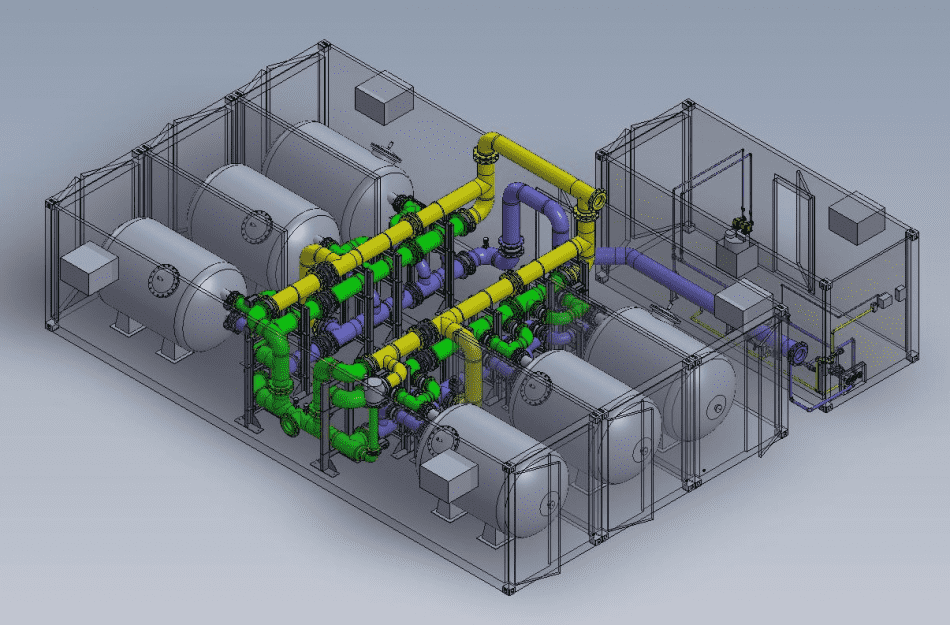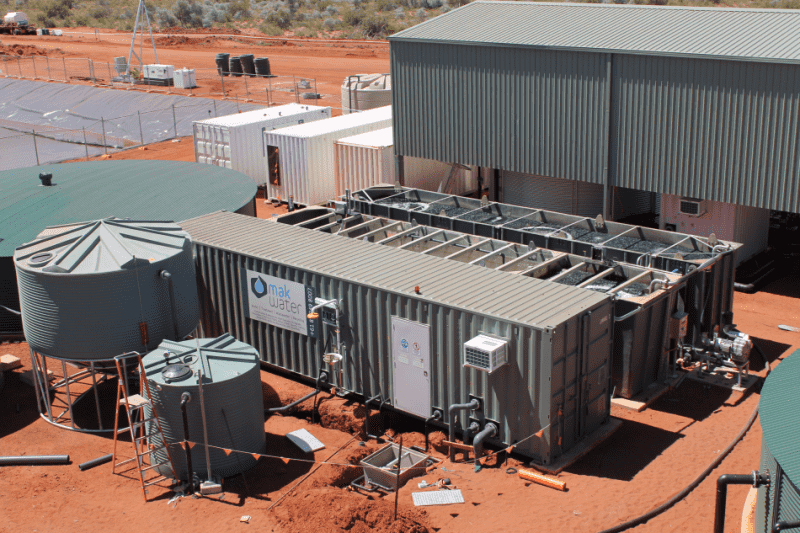Background
A leading global producer of lithium required process water and potable water for a new lithium hydroxide (LiOH) conversion plant at Kemerton, approximately 160km south of Perth, WA. MAK Water was contacted by a local water provider which had an opportunity to enter into a long-term agreement for the supply of water to the project.
MAK Water worked closely with both the water provider and the client to review water data, provide technical assistance and design & deliver the best possible treatment solution. The client was looking for a smart technical solution that minimised water usage and wastewater discharge. The water provider needed to partner with an experienced OEM capable of providing technical support for the equipment delivery phase and operational support for the life of the project.
The facility built by MAK Water consisted of a custom package of six separate plants with our premium instrumentation package, installed in a purpose-built structure with additional tanks and equipment, delivery to site, installation, commissioning and operator training, plus a long-term service and maintenance agreement and ClearAccess™ remote access.
Solution
The primary treatment process is a skid mounted Multimedia Filtration (MMF) system designed to treat dam water and produce 4,200 m3/day of process water for the facility.
The second plant in capacity terms is a skid mounted twin-train, two-stage Brackish Water Reverse Osmosis (BWRO) plant treating a blend of filtered dam water from the primary multimedia filtration plant and filtered bleeds blowdown water from plant 3 to produce 1,144 m3/day of strictly specified demineralised boiler feed water.
The third subsystem is a Multimedia Filtration (MMF) plant consisting of glass media, DMI 65 media and GAC media filtration stages, designed to treat boiler bleeds blowdown water for recycling and produce 939m3/day of feed water for the previously described BWRO system.
MAK Water Key Solutions
RAW DAM WATER MULTIMEDIA FILTRATION
- 2 x 50% glass media filters
- Chemical dosing: coagulant, chlorine
- Duty standby (2x 100%) backwash and chemical dosing pumps
- 1 x 200kL feed water tank
DEMINERALISED BOILER FEED WATER PRODUCTION
- 2 x 50% RO process trains
- High recovery 2 stage RO design
- Chemical dosing: pH adjustment, de-chlorination, anti-scalant
- Duty standby (2 x 100%) chemical dosing pumps
- 4 x 33% distribution pumps for boiler feed
- 2 x 50kL RO feed tanks
- 2 x 230kL RO permeate tanks
- 2 x 230kL RO brine tanks
- Meets customer’s strict specifications for demineralised water
BOILER BLOWDOWN MULTIMEDIA FILTRATION
- Multimedia filtration
- DMI-65 media filtration
- 2x100% duty standby granular activated carbon (GAC) filtration
- Chemical dosing: acid, chlorine and de-chlorination Duty standby (2 x 100%) chemical dosing pumps
- 3 x 50% feed/backwash pumps
- RO dilution/transfer pump
- 2 x 50kL bleeds blowdown tanks
MMF BACKWASH WATER CLARIFICATION
Our customer needed to utilise their dam water allocation as efficiently as possible to maximise their production potential within their license agreement for responsible water consumption. This means recycling as much water on site as is feasible. To this end, we incorporated a Lamella Clarifier (LC) plant designed to treat 15 m3/h of backwash water from the two process MMF plants and recycle it to produce more BWRO feed water.
- Lamella clarifier with feed pump, flocculation tank with mixers, sludge pump
- Chemical dosing: coagulant, polymer
- 3 x 50kL backwash water tanks
- 1 x 22kl sludge tank
LAMELLA SLUDGE DEWATERING
To further reduce dam water consumption as well as waste disposal costs, the sludge waste from the Lamella Clarifier is then sent to a skid mounted Dewatering Screw Press (DSP) designed to dewater 3m3/h of sludge from the Lamella Clarifier plant and produce dewatered solid waste cake and water which is recycled.
- Dewatering screw press with feed pump
- Chemical dosing: polymer
- Frame/skid mounted solution for shed installation
- Polymer makedown unit
- Pressate pump station for return to backwash waste tank
POTABLE WATER TREATMENT (MMF)
Separate to the 5 previous plants described in the process water treatment plant, MAK Water also supplied a containerised Multimedia Filtration (MMF) and distribution plant designed to treat bore water and produce 167m3/day of potable water.
- Multimedia filtration, DMI-65 media filtration and cartridge filtration
- Chemical dosing: pH adjustment and chlorine
- Potable tank recirculation and monitoring of free chlorine and pH levels
- 3 x 50% distribution pumps for potable water and safety water
- Duty standby (2 x 100%) process and chemical dosing pumps
- Safety shower and eyewash station
- Premium instrumentation package with ClearAccess™ Remote Access
- Containerised (1 x 20’) solution for easy installation
- 1 x 200kL potable water tank
Results and benefits
- Bulk pre-filtration. Dam water is efficiently filtered before distribution to downstream treatment processes
- Plant reliability. Duty standby systems, combined with custom design and quality equipment combined protects productivity
- High recovery. Custom 2-stage RO design to achieve high permeate recovery rate, minimising precious dam water consumption and brine waste discharge
- Plant reliability. Duty standby chemical dosing, and 4x 33% distribution pump set protects water supply volume and specification even in case of equipment failure
- Asset protection. Strictly controlled and accurate demineralised water protects boiler systems, maximising their performance and lifespan
- Wastewater recycling. Treatment of bleeds blowdown wastewater for reuse as RO feed water drastically reduces dam water consumption and wastewater discharge
- Built-in redundancy. Duty standby GAC filtration and oversized chemical and filtrate pump systems, protects water supply even in case of equipment failure.
- Wastewater recycling. Treatment of backwash water from MMF for reuse as RO feed water to minimise precious dam water consumption and wastewater discharge
- Compact footprint. Lamella system reduces equipment footprint substantially vs traditional gravity settling process
- Minimised water consumption. Pressate is recycled back to into the system
- Reduced waste discharge. By concentrating solid waste
- Cost reduction. Lowered waste disposal costs by concentrating solids
- Compliance. Achieves required potable water compliance with ADWG
- Built-in redundancy. Potable water supply protected by duty standby chemical dosing and pumping systems.
- Cost effective. Lower volume allowed bore water to be used as a source, reducing water costs.
Up next








